-
January 27, 2020 by Total Fire and Safety
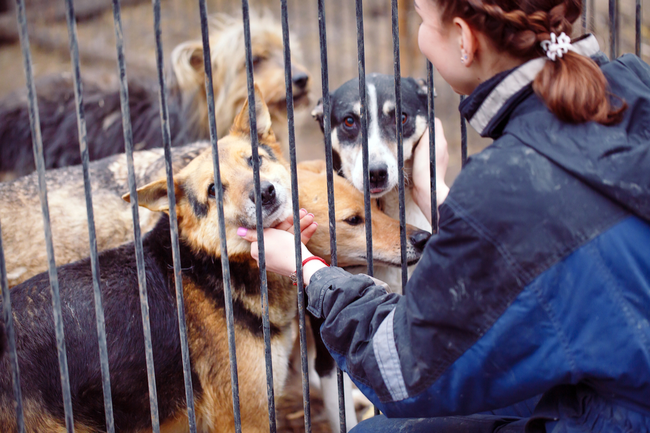
How important is the fire code for animal shelters? Deadly fires at kennels and animal shelters are not uncommon across the U.S. In the past year, over 100 dogs have died in kennel fires, including here near Chicago.
On the night of January 14, 2019, a West Chicago animal kennel went up in flames. Thirty-one dogs perished in the fire. The exact cause of the fire is unknown, but investigators determined no staff was present at the time and no working fire sprinklers were on property. The kennel did have fire detectors, but no one was around to hear them.
The tragedy prompted lawmakers to come up with legislation to ensure such an event never happens again. The new law, signed in August, went into effect January 1. The legislation requires kennels to be staffed 24/7 or have sprinkler systems or alarms that alert local fire departments.
When it comes to arming animal shelters with lifesaving equipment, Total Fire and Safety can help with the installation of …..
Wireless Fire Alarms
- Preferred by fire departments, they are more reliable than land-based systems for their quick and accurate response.
- They can save phone line costs.
- They reduce false alarms to fire departments
- Minimal and guaranteed wireless radio alarm monitoring fees
Fire Sprinkler Systems
- A working fire sprinkler is 96% effective in containing a fire.
- Monthly, quarterly, and annual inspections are necessary to ensure safety and keep your building fire code compliant.
- TFS uses the most up-to-date technology and thorough process to prevent sprinkler failure.
Working fire extinguishers can keep a small fire from getting out of control when someone is in the facility. Every business needs working fire extinguishers at the ready, and be trained to use them.
- A fire extinguisher is your first line of defense, 24/7.
- 30% of fire extinguishers are not in working order. We complete a 12-point inspection to make sure they are fire ready.
- On-site training is provided to guarantee proper employee usage.
All it takes is basic fire protection to save animal and human lives.
Illinois’ new fire code will help protect our furry friends from another senseless tragedy and prevent irreparable damage to lives, structures, and pocketbooks. Total Fire and Safety can equip your facility with the latest fire protection and help maintain the equipment installed. Give us a call today at (630) 960-5060.
Category: Business Safety, Fire Alarm Monitoring, Fire Extinguishers, Fire Extinguishers, Fire News, Fire Safety, Sprinkler Systems, Total Fire and Safety Tags: commercial fire safety, commercialfiresprinkler, employee training, fire and safety equipment, fire and safety solutions, fire safety in the news, Firesprinkler, Total Fire and Safety, wireless fire alarm monitoring, wireless fire alarms, wireless fire alarms for business | Comments Off on A New Fire Code for Animal Shelters in Illinois!
-
December 23, 2019 by Total Fire and Safety

We wish you the warmth and cheer of the season!
Thank you for your continued support throughout the year.
From all of us at Total Fire & Safety
Twelve Days of Fire Safety
On the first day of safety, Total Fire gave to me…
A safe and code compliant facility!
On the second day of safety, Total Fire gave to me…
Two emergency plans
and a safe and code compliant facility!
On the third day of safety, Total Fire gave to me…
Three eyewash stations
Two emergency plans
and a safe and code compliant facility!
On the fourth day of safety, Total Fire gave to me..
Four first aid kits
Three eyewash stations
Two emergency plans
and a safe and code compliant facility!
On the fifth day of safety, Total Fire gave to me…
FIVE WIRELESS ALARMS
Four first aid kits
Three eyewash stations
Two emergency plans
and a safe and code compliant facility!
On the sixth day of safety, Total Fire gave to me…
Six extinguishers inspected
FIVE WIRELESS ALARMS
Four first aid kits
Three eyewash stations
Two emergency plans
and a safe and code compliant facility!
On the seventh day of safety, Total Fire gave to me…
Seven exit signs Six extinguishers inspected
FIVE WIRELESS ALARMS
Four first aid kits
Three eyewash stations
Two emergency plans
and a safe and code compliant facility!
On the eight day of safety, Total Fire gave to me…
Eight backflow inspections
Seven exit signs
Six extinguishers inspected
FIVE WIRELESS ALARMS
Four first aid kits
Three eyewash stations
Two emergency plans
and a safe and code compliant facility!
On the ninth day of safety, Total Fire gave to me…
Nine sprinkler systems
Eight backflow inspections
Seven exit signs
Six extinguishers inspected
FIVE WIRELESS ALARMS
Four first aid kits
Three eyewash stations
Two emergency plans
and a safe and code compliant facility!
On the tenth day of safety, Total Fire gave to me…
Ten safety trainings
Nine sprinkler systems
Eight backflow inspections
Seven exit signs
Six extinguishers inspected
FIVE WIRELESS ALARMS
Four first aid kits
Three eyewash stations
Two emergency plans
and a safe and code compliant facility!
On the eleventh day of safety, Total Fire gave to me…
Eleven fire pumps serviced
Ten safety trainings
Nine sprinkler systems
Eight backflow inspections
Seven exit signs
Six extinguishers inspected
FIVE WIRELESS ALARMS
Four first aid kits
Three eyewash stations
Two emergency plans
and a safe and code compliant facility!
On the twelfth day of safety, Total Fire gave to me…
Twelve new extinguishers
Eleven fire pumps serviced
Ten safety trainings
Nine sprinkler systems
Eight backflow inspections
Seven exit signs
Six extinguishers inspected
FIVE WIRELESS ALARMS
Four first aid kits
Three eyewash stations
Two emergency plans
and a safe and code compliant facility!
Category: Fire Alarm Monitoring, Fire Equipment Inspections, Fire exits, Fire Extinguishers, Fire News, Fire Safety, Sprinkler Systems, Total Fire and Safety, Uncategorized Tags: commercial fire safety, fire and safety equipment, fire and safety solutions, Fire Extinguisher, fire safety, Total Fire & Safety, wireless fire alarms | Comments Off on Happy Holidays from Total Fire & Safety
-
October 2, 2019 by Total Fire and Safety
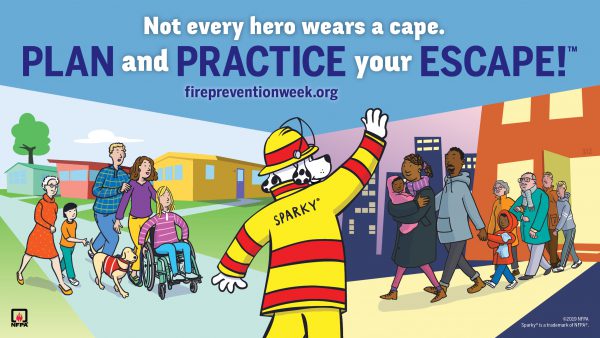
Fire prevention week has been designated as October 6-12, 2019 by the National Fire Protection Association (NFPA). Fire prevention week has a long history, dating back to 1925, when President Calvin Coolidge proclaimed fire prevention week as a national observance. Now, it has become the longest running health observance in the country.
At Total Fire & Safety, we use this time to reiterate to our clients how important it is to stay compliant with NFPA codes and keep everyone within their buildings, warehouses and commercial spaces supplied with fire extinguishers, sprinklers, and suppression systems that are ready to go when fire strikes.
The theme of this year’s campaign is “Plan and Practice Your Escape.” So how can a business observe National Fire Prevention Week? Here’s a few ideas.
- Share safety information from the NFPA with your employees. Not only will it help them at work, but at home too!
- If you do not do so regularly, heed the theme of the program and “plan and practice your escape.” Every employee should be mindful of their best options in the event of an emergency.
- Call your fire protection service for an inspection of your equipment and make sure all your extinguishers, alarms, sprinkler systems, etc. are in working order.
- Consider a training class for fire extinguisher operation, first aid, or CPR.
Around the Total Fire & Safety service area, the observance is being commemorated with lots of events at community fire stations. For more information, see the website for each individual fire department.
Friday, Oct. 4
Saturday, Oct. 5
- Tinley Park Fire Department: 17355 68th Court, Tinley Park, 9 a.m. – 1 p.m. Open House
- Schaumburg Fire Department: 950 W. Schaumburg Road, Schaumburg, 11 a.m. – 2p.m. Public Safety Open House
- Clarendon Hills Fire Department: 316 Park Ave., Clarendon Hills, 11 a.m. – 2 p.m. Open House
- Minooka Fire Department: 7901 E. Minooka Road, Minooka, 11 a.m. – 2 p.m. Open House
- Hazel Crest Fire Department: 2903 W. 175th St., Hazel Crest, 9 a.m. – 12 p.m. Open House
- Frankfort Fire District: 20101 La Grange Road (Event address), Frankfort, IL 60423, 9:30 a.m. – 12:30 p.m. Gas Safety Event
- Palatine Fire Department: 39 E Colfax Street, Palatine, IL 60067, 10 a.m. – 2 p.m. Open House
- Darien-Woodridge Fire District: 7550 Lyman Ave., Darien, IL 60561, 10 a.m. – 1 p.m. Open House
- Oswego Fire Protection District: 3511 Woolley Road, Oswego, IL 60543, 11 a.m. – 3 p.m. Open House
- Calumet City Fire Department: 24 State Street, Calumet City, IL 60409, noon
Sunday, Oct. 6
- Belvidere Fire Department: 123 S. State Street, Belvidere, IL 61008, 1 – 4 p.m. Open House
- Mokena Fire Protection District: 19853 S. Wolf Road, Mokena, IL 60448, 7:30 a.m. – noon Open House
- Lake Zurich Fire Department: 321 South Buesching Road, Lake Zurich, IL 60047, 11 a.m. – 2 p.m. Open House
- Batavia Fire Department: 1400 Main St, Batavia, IL 60150, 11 a.m. – 3 p.m.
- McHenry Township Fire Protection District: 3610 W. Elm Street, District Administration Office, McHenry, IL 60050, 11 a.m. – 1 p.m.
- Naplate Fire Department: 2000 W Ottawa Ave, Naplate, IL 61350, 12 – 3 p.m.
- Manteno Community Fire Protection District, 13 S WALNUT ST, MANTENO, IL 60950, 12 – 3 p.m.
Monday, Oct. 7
- Western Springs Fire Dept: 4353 Wolf Road, Western Springs, IL 60558, 6 – 8:30 p.m. Open House
Wednesday, Oct. 9
- Lombard Fire Department: 50 E St Charles Road, Lombard, IL 60148, 6 – 8 p.m. Open House
- Downers Grove Fire Department: 6701 Main Street, Downers Grove, IL 60516, 6:30 – 8:30 p.m. Open House
Thursday, Oct. 10
Friday, Oct. 11
- South Chicago Heights Fire Department: 185 W Sauk Trail, South Chicago Heights, IL 60411, 5:30 – 7:30 p.m. Open House
Saturday, Oct. 12
- Northbrook Fire Department: 1840 Shermer Road, Northbrook, IL 60062, 9 a.m. – 12 p.m. Open House
- Crystal Lake Fire Rescue: 100 W Woodstock St, Crystal Lake, IL 60014, 9 a.m. – 12 p.m. Open House
- Prospect Heights: 10 E. Camp McDonald Rd, Prospect Heights, IL 60031, 9 a.m. Open House
- La Grange Park Fire Department: 447 N. Catherine Ave., La Grange Park, IL 60526, 10 a.m. – 1 p.m. Open House
- Elgin Fire Department: 650 Big Timber Road, Elgin, IL 60123, 10 a.m. – 3 p.m. Open House
- City of Rockford: 204 S. First St., Rockford, IL 61104, 10 a.m. – 1 p.m.
- Homewood Fire Department: 17950 Dixie Highway, HOMEWOOD, IL 60430, 11 a.m. to 2 p.m.
- Plainfield Fire Protection District: 23748 W. 135th Street, Plainfield, IL 60544, 11 a.m. – 2 p.m. Open House
- Westmont Fire Department: 6015 S. Cass Ave., Westmont, IL 60559, 11 a.m. – 3 p.m. Open House
- Alsip Fire Department: 11946 S. Laramie, Alsip, IL 60803, 1 – 3:30 p.m. Open House
- Calumet City Fire Department, Station 2: 1270 Pulaski Rd, Calumet City, 12 – 3 p.m. Open House
Sunday, Oct. 13
- North Palos Fire Protection District: 10629 S Roberts Rd, Palos Hills, IL 60465, 7 a.m. – 12 p.m.
- Byron Fire Department: 123 S. Franklin St., Byron, IL 61010, 11 a.m. – 3 p.m. Open House
- Elmhurst Fire Department: 601 S York, Elmhurst, IL 60126, 12 – 4 p.m. Open House
Wednesday, Oct. 23
- Chicago Ridge Fire Department: 10063 Virginia, Chicago Ridge, IL 60415, 6 – 9 p.m.
Fire protection and preparation is not just a week-long observance but a 365 day a year, 24/7 job. At Total Fire & Safety, we have everything you need to keep your employees and tenants protected. If we can ever assist your business with NFPA compliance for your commercial fire protection, contact us at 630-960-5060.
Category: Business Safety, Fire Equipment Inspections, Fire exits, Fire News, Fire Safety, Health and Safety, LED Lighting, NFPA Compliance, Total Fire and Safety Tags: commercial fire safety, emergency exit lights, fire and safety equipment, fire and safety needs, fire and safety solutions, fire safety in the news, lifesafety | Comments Off on 2019 Fire Prevention Week is for Businesses Too!
-
June 19, 2019 by Total Fire and Safety
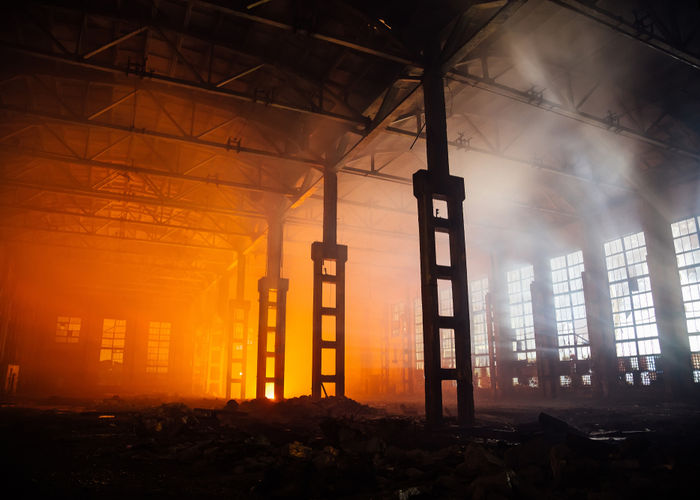
According to legend, the cause of the greatest fire in Chicago was a cow kicking over a lantern in a barn. In 1871, the entire city of Chicago was engulfed in flames. The fire lasted two days, left 300 people dead and over $200 million in damage. The event changed Chicago. Stricter fire codes were implemented, structures were built with different materials, and fire departments were equipped with better equipment and advanced training methods.
Today, fires in Chicago rarely go unexplained due to investigative divisions within the fire departments. The investigative teams are well trained in how to identify common causes of fires in Chicago. The most common causes of fires in Chicago vary by type.
Common Causes of Residential Fires
- Overusing extension cords
- Overusing Christmas lights/stringing them together under furniture
- Smoking materials (cigarettes, cigars, etc.…)
- Heating or electrical malfunction
- Cooking or kitchen fires
Common Causes of Industrial Fires
- Combustible dust
- Hot work
- Flammable gas or liquid
- Equipment and machinery fires
- Electrical hazard fires
How Fires are Investigated
Whether it is a residential fire or industrial fire, criminal or accidental, fires in Chicago and around the country all have a determining factor. The responsibility for finding the determining factor is up to the fire department. From a public standpoint, finding a cause seems impossible. How do they do it?
Upon arriving at the scene, firefighters note the color of the flames, the amount of smoke, the rate at which the fire spreads, and the sound it makes. These are all clues as to what is burning and how it is burning. It is incumbent of the firefighters to protect the evidence at the scene by:
- Limiting excessive fire suppression
- Preventing needless destruction to a property
- Using markers or cones to identify evidence
- Writing notes or making voice recordings of observations
- Covering areas that contain evidence
- Preserve delicate evidence like shoe or tire tracks
Once the fire is extinguished, the fire investigators dig through the ashes. They take photographs prior to and during the investigation for documentation. The objective of investigators is to locate the point of origin. This is achieved through the char patterns, direction of melt, and heat shadows. The burn patterns are often “V” shaped like an inverted cone. The fire burns upward, in a V-shaped pattern away from point of origin. The location is usually the most damaged by the fire. Although most of the determination of origin is science-based, there is a little bit of guessing and witness accounts. Fires in Chicago are likely to have one of four reasons:
- Electrical issues
- Natural acts
- Open flames
- Human action
Fires in Chicago have decreased over the years with an average of eight fire per day. Fortunately, fatal fires are rare, but even one is too many. It’s important for residents and businesses to practice fire safety. Is your business well equipped against fires? Total Fire and Safety can help safeguard your building and those occupying it with fire alarms, fire extinguishers, first aid kits, emergency lights and more. We’ll inspect your property to ensure it is up to code and even provide training classes for employees so they know how to use the equipment in an emergency. Give TFS a call today at 630-960-5060.
Category: Business Safety, Fire Extinguishers, Fire News, Fire Safety Tags: commercial fire protection, commercial fire safety, fire and safety solutions, Fire Extinguisher, fireextinguisher, firesafetytraining | Comments Off on In the Aftermath: Finding the Causes of Fires in Chicago
-
September 19, 2018 by Total Fire and Safety
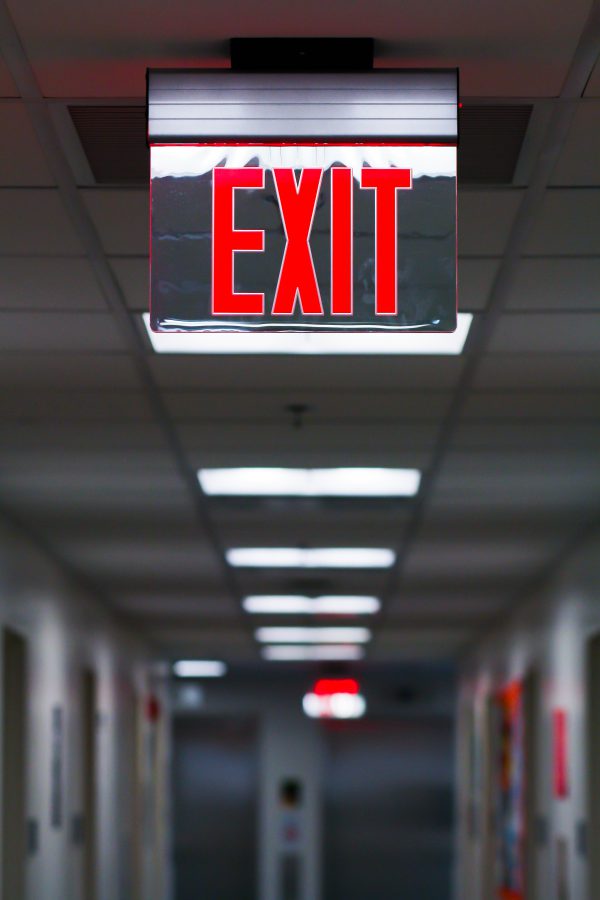
Campus fire safety is not likely a hot button issue with college students or parents when they first move on campus. But fires occur on college campuses more than parents and students realize. According to The Center for Campus Fire Safety, between 2000-2018, more than 92 fatal fires killed 132 people on college campuses, Greek housing, or off-campus housing within three miles of college housing. The NFPA reports that U.S. fire departments responded to an average of 3,870 fires in dormitories and Greek housing from 2009 to 2013. Cooking equipment accounts for 86 percent of the fires.
Most dormitories have specific rules and regulations in place to reduce the possibility of fire, but sometimes drugs and alcohol consumption can inhibit a student’s ability to recognize danger zones. It’s worth mentioning to your child that special care must be taken with the following items, even when they allowed by residence:
- Space heaters
- Candles
- Stovetops
- Cooking utensils
- Smoking
- Overloaded power strips
When you move your child in, you can help keep them safe by keeping fire safety in mind:
- Check for smoke alarms and fire sprinklers. These should be located in hallways, lobbies, bathrooms, bedrooms, etc.
- Look for a posted escape route. If there are no plans posted, make one.
- Check with school officials when and how often fire drills are planned. There should be fire drills on-campus, in Greek housing and off-campus housing.
- Keep all exits clear for a safe escape path.
- Do not use flame candles, opt for battery operated candles.
- Practice fire safety in the kitchen. Do not leave food cooking unattended and do not cook when tired or in a compromised state. Unplug appliances. Do not put out grease fires with water.
- Do not overload outlets.
- Turn off electronics and appliances, like computers, hair tools, etc. Hit the off button when leaving the room.
- Clean the lint trap from the dryer, before and after each use.
- Smoke outside! Do not dispose of cigarettes, etc. in the garbage.
Unfortunately, one of these potential fire hazards became real when a mother lost her daughter in a fire while she was attending Reed College near Portland, Oregon. Because of this tragedy, the victim’s mother partnered with the Portland Fire and Rescue to promote the “Zero Death Initiative.” The program aims to educate students, who are on their own for the first time, about fire safety.
Starting college is a big step into a new world for everyone but campus fire safety should not be lost in the fray. Take the precautionary measures now so your child can stay focused on the year ahead. Total Fire and Safety keeps residential buildings equipped and compliant with proper fire code regulations. To find out more about what we do, give us a call at 630-960-5060.
Category: Fire exits, Fire Extinguishers, Fire News, Fire Safety, Total Fire and Safety Tags: emergency exit, emergency exit lights, escape route, fire and safety equipment, fire drill, Fire Extinguisher, fire safety, Firesprinkler, safety, smoke alarms | Comments Off on Parent’s Guide to Campus Fire Safety
-
August 23, 2018 by Total Fire and Safety
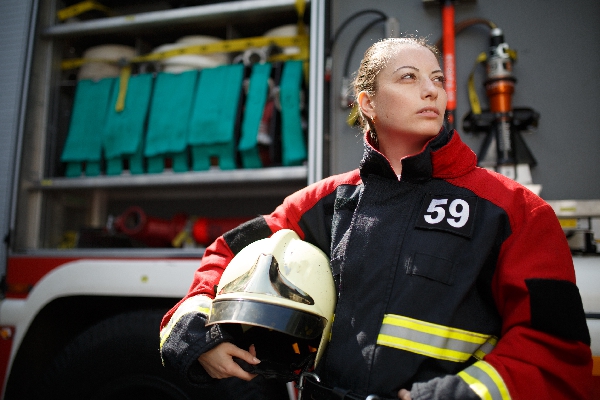
Are there more women firefighters in our future? YES! Groups of Suburban Chicago young women are proving it. This past summer a local Fire Protection District hosted a Girls Firefighter Summer Camp which was enthusiastically attended by many girls who are considering firefighting as a career. The girls learned all aspects of firefighting through hands-on training, like climbing ladders, treating patients, and putting out fires, etc. The goal of the camp was to show girls they can do the job, but they need look no further than the past and the present for their role models and inspiration.
Women Firefighters in History
Women have been firefighters for over 200 years which is an amazing fact in an industry so dominated by males.
- Molly Williams was the first woman firefighter. She was a slave in New York City until she became a member of Oceanus Engine Company #11 in 1815. Although she was as tough as the men, she always wore a calico dress and checkered apron to the fires.
- In 1820, Marina Betts joined the Pittsburgh fire department, a career that lasted 10 years.
- During WWII, two military fire departments in Illinois were staffed entirely by women volunteers.
- Lauren Howard was the first career female firefighter in Chicago. She joined the force in 1980 and was the only woman until 1986.
Women Firefighters Today
According to NFPA (National Fire Protection Association), 252,000 women work in the firefighting industry, but nationwide, only 4% of firefighters are women, a staggering number when compared to the 90% of women nurses and 97.5% of women teachers. In fact, females in farming and construction have a higher percent than female firefighters.
The International Fire Chief’s Association started a council for women fire chiefs in 2017 to network, share ideas and identify strategies to improve their organization. The council of 16 represented approximately 50 female fire chiefs across the country.
Even for the strongest female, the road to firefighting is not easy. Cities like Joliet, Illinois are hiring their first female recruit this year in their long, century old history. Another department in East Point, Georgia recently made headlines by hiring the first ever African-American female fire chief in the United States.
Male and Female Qualities
Let’s face it. When someone’s house is burning, most people don’t care if it’s a man or woman who shows up to help…they just want a good firefighter. And the attributes of a good firefighter are numerous and have nothing to do with gender.
- Honest and dependable
- Learns quickly; can remember and use their training when the pressure is on
- Physically fit; is committed to a healthy lifestyle and to maintaining fitness
- Functions well as part of a team
- Cares about and respects co-workers and members of the community
- Communicates and listens well
- Is dedicated to her/his work
- Has, and uses, common sense
- Is emotionally stable and deals with stress appropriately
- Has a sense of humor
- Is open-minded and flexible, willing to try new things and listen to new ideas
At Total Fire & Safety, we believe our work in inspection, installation and maintenance of fire safety equipment helps keep firefighters safe by helping minimize fire damage and providing what’s needed to fight fires until the force arrives. We salute all fire fighters and especially the brave women of the force who work to keep us safe!
Category: Fire News, Total Fire and Safety Tags: fire safety, fire safety in the news, Total Fire & Safety, Women Firefighters | Comments Off on Are There More Women Firefighters in Our Future?
-
June 21, 2018 by Total Fire and Safety
Everyone has seen the fire hydrants on the side of the road and everyone knows how important they are for firefighters to do their job. Can you 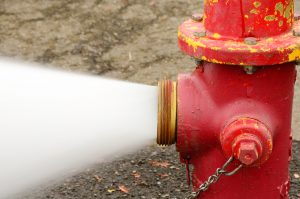 imagine what would happen if in the heat of an emergency, a fireman hooked up the hose to the hydrant and it failed? That’s why municipalities perform regular inspection and maintenance on “public” fire hydrants. imagine what would happen if in the heat of an emergency, a fireman hooked up the hose to the hydrant and it failed? That’s why municipalities perform regular inspection and maintenance on “public” fire hydrants.
However, you may also have fire hydrants installed on your private property which are considered yours to inspect and maintain. The National Fire Protection Association (NFPA) has a standard that is adopted by many village ordinances and outlines the inspection, testing and maintenance requirements that need to be followed.
In other words, to ensure the health of the overall water supply system and the proper functioning of the hydrants located most closely to your business, it is your responsibility to maintain any fire hydrants on your private property.
Recently, the Village of Downers Grove began notifying building owners who have hydrants on their private property of any need for routine inspection, testing and maintenance. The Village is setting an aggressive schedule for ensuring all municipal water mains and hydrants receive the proper testing as outlined by the NFPA standard by September 1. Property owners can contact any commercial fire protection company they want to complete the inspection.
If you need fire hydrant service, Total Fire & Safety can help! We are a trusted, full-service provider of commercial fire protection that has been serving the Village of Downers Grove for more than 30 years.
Our fire hydrant service includes:
- Full inspection
- Any needed repair
- Reporting to DGFD and all third parties (www.theComplianceEngine.com) as directed by the Fire Department
If you are not sure of whether your fire hydrants are in compliance, you can check with the Village of Downers Grove Water Department at 630-434-5460 or the Downers Grove Fire Department at 630-434-5983.
If you would like to schedule your hydrant service today, contact us at 630-960-5060.
Testing ensures the proper flow and flushes debris from the hydrant.
Category: Business Safety, Fire News, Total Fire and Safety Tags: downers grove, downers grove fire, downers grove il, fire hydrant inspection, fire hydrant safety, fire hydrants, fire hydrants il | Comments Off on Downers Grove Businesses: Your Fire Hydrants May Need Inspection
-
March 21, 2018 by admin
Join us for the 2018 Fire Safety Symposium
at Total Fire & Safety!
Register below! Space is limited!
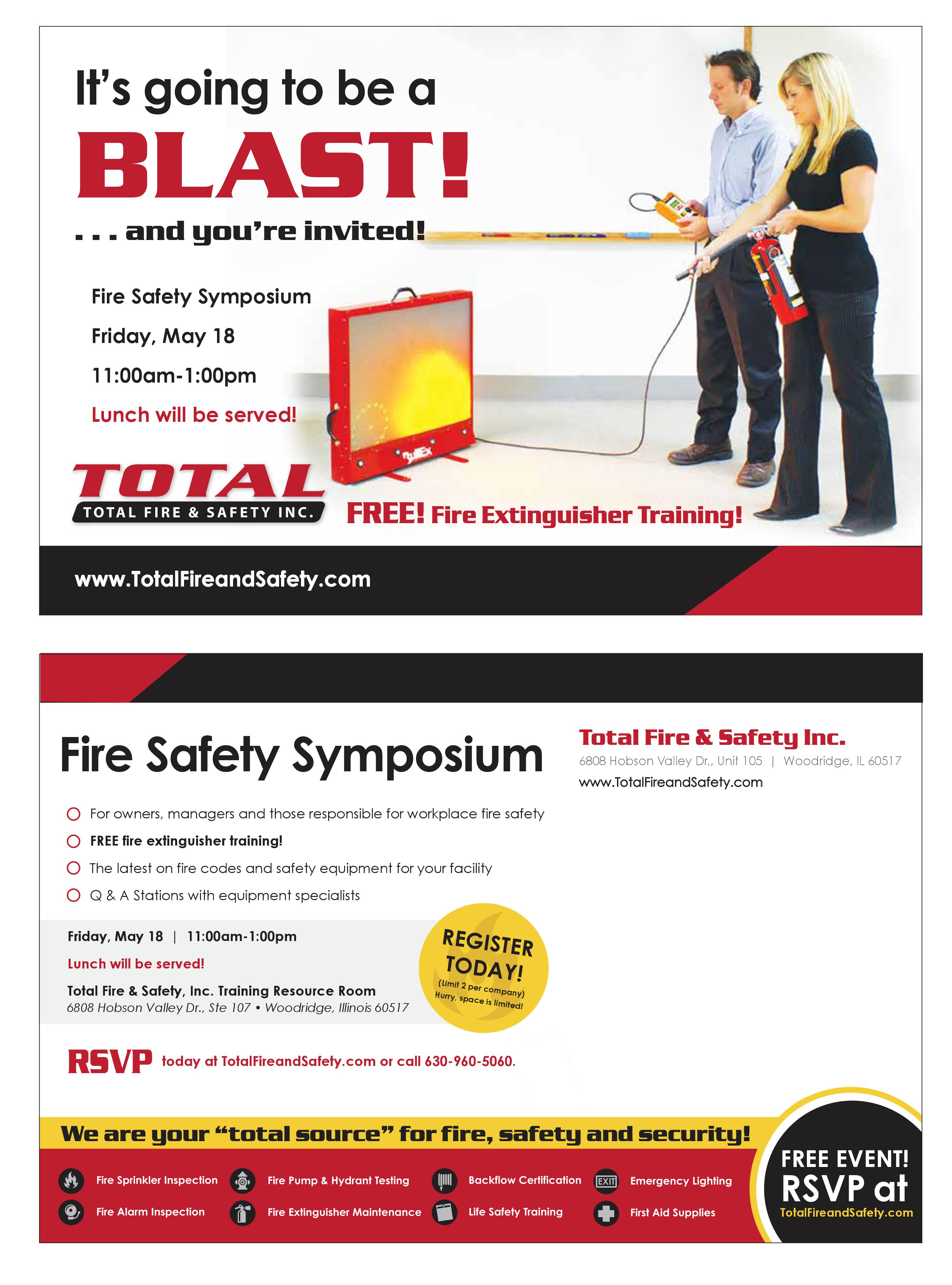
Category: Business Safety, Client Events, Fire Extinguishers, Fire Extinguishers, Fire News, Fire Safety Tags: commercial fire safety, employee training, fire and safety equipment, fire and safety solutions, Fire Extinguisher, fire safety, fireextinguisher, Fireextinguishertraining, Total Fire & Safety, Total Fire and Safety, training | Comments Off on Fire Safety Symposium
-
March 15, 2018 by Total Fire and Safety
 Nobody thinks much about emergency exit lights. But if the power suddenly goes out, smoke fills the room and you can’t see a foot in front of you, relying on the emergency lights may be your only means of escape. Nobody thinks much about emergency exit lights. But if the power suddenly goes out, smoke fills the room and you can’t see a foot in front of you, relying on the emergency lights may be your only means of escape.
Emergency exit lights are essential to safety in any dangerous situation. They can alarm someone in a fire, be the only source of light in the dark, and the key to safely exiting the building. Emergency exit lights are often overlooked and taken for granted, but take note of how many you come across every day. Do you realize how many requirements and regulations go into the installation and maintenance of one exit sign?
There are numerous agencies that govern emergency exit lighting and signs: OSHA (Occupational Safety and Health Administration), NFPA (National Fire Protection Administration, JCAHO (Joint Commission on Accreditation of Healthcare Organizations and the International Building Code and International Fire Code. Above all these agencies, the local authority is responsible for monitoring and enforcing building/fire codes.
According to OSHA, an exit route is defined as a continuous and unobstructed path of exit travel from any point within a workplace to a place of safety. There are three parts to an exit route:
- Exit access-part of the exit route that leads to an exit.
- Exit-part of the exit route that is separated from other areas and provides a safe means of travel to exit discharge.
- Exit discharge-part of the exit route that leads to directly outside or refuge area.
OSHA’s requirements for the lighting of these afore mentioned exit routes is covered under 1910.37(b). It states that each exit route must be sufficiently lighted so an employee with normal vision can see along the exit route and each exit must be clearly visible and marked by a sign reading “EXIT.” Additional information for OSHA requirements can be found at www.osha.gov.
The NFPA guidance for emergency exit lighting and signs can be found in the NFPA 101, Life Safety Code. The NFPA’s Life Safety Code provides information for placement, illumination, and visibility for exit signs.
- Placement of exit sign. Any exit signs must be located so that no point in an exit access area is more than the sign’s viewing distance, or 100 feet from the nearest sign.
- Visibility of exit signs-Every sign must be located and of such size, distinctive color and design that is visible and contrasts from the background of its placement. NFPA also states no decorations, furnishings, or equipment that impairs visibility of a sign shall be permitted. Nothing should be placed near an exit sign that distracts attention and inhibits visibility of an exit sign.
- Illumination of Exit Signs-The NFPA states all exit signs must be illuminated by a reliable light source and legible in normal and emergency exit lighting modes. There are two categories of illumination: external illumination, which comes from outside the exit sign and internal illumination, which comes from a source inside an exit sign.
According to the NFPA, emergency illumination must be provided for a minimum of 1.5 hours in the event of power outage. The emergency lighting must be illuminated not less than an average of one lumen per square foot. The maximum illumination at any point can be 40 times the minimum illumination. All emergency exit lighting must be able to provide lighting automatically when normal light is interrupted.
Many emergency exit lights are now using LED lights. The NFPA states that LED lights are longer lasting, provide better light and are most durable. In emergency situations, LED lights emit sufficient lighting and are most effective when placed properly. They are also most energy efficient, saving the building money.
According to the NFPA requirements for testing, there are three categories of emergency lights: traditional, self-testing, and computer base self-testing. A monthly activation test which involves having the lights illuminate for no less than 30 seconds and an annual test which keeps the lights illuminated for 1.5 hours, simulating a long-term emergency. Records of these test must be maintained for inspection.
Many regulations, codes, and considerations go into the signs and lights you see every day so it is important to have regular maintenance and testing of these lights. Total Fire and Safety has a knowledge team for inspecting emergency exit lighting. With regular maintenance and testing from Total Fire and Safety, you can be assured your emergency exit lighting is up to code and the safety of your employees/tenants is assured. Give us a call today 630-960-5060.
Category: Business Safety, Fire code violation, Fire Equipment Inspections, Fire exits, Fire News, Fire Safety, Health and Safety, LED Lighting, NFPA Compliance, Total Experience, Total Fire and Safety Tags: commercial fire protection, commercial fire safety, emergency exit lights, emergency lighting, fire and safety equipment, fire and safety needs, fire and safety solutions, fire safety in the news, fire safety solution, fire safety training, lifesafety, safety | Comments Off on Are You In the Dark About Emergency Exit Lights?
-
August 1, 2017 by Total Fire and Safety
Thank you to our client, Discount Tire, who chose a beautiful day for their recent annual golf outing. It was held July 27 at the lovely Tamarack Golf Course in Naperville, Illinois. This was the third consecutive year we participated, sending a fearless foursome to the golf outing and we were as always, happy to support our client.
This year, we even sponsored a hole with handsome, environmentally appropriate signage to add to the festivities.
The foursome representing Total Fire & Safety came from varied key service areas of the company. Pictured here are some of our finest employee golfers! From left to right, Jason Schroeder, Vice President; Jason LeGrand, Business Development; Nick Ingoglia, Fire Division Manager and Chris Burroughs, Dispatch Coordinator.

Were it not for the tournament, would these four fire safety men be on the golf course? Golf courses are not typically a fire risk, but fire has been known to destroy the maintenance buildings and club houses that sit adjacent to them. At Total Fire & Safety, our services protect many recreational venues in Chicagoland, Wisconsin and Indiana. And that’s important because such fires break out more often than you think.
In fact, this past May, a Texas and Ohio golf course building were both destroyed from fire.
In Brownsville, Texas, the clubhouse at Valley International Country Club had a blaze on May 13, which most likely began in the kitchen area. Although nobody was hurt, the beautiful venue, including the original two-story clubhouse built in 1910, was ruined. The fire was fueled by a “built-up roof” which was heavier and held the heat more easily as the blaze raged for 12 hours.
Just a few days earlier, fire had destroyed a maintenance shed at the Carlisle Golf Course in Grafton, Ohio. The fire broke out after midnight on May 11 from an unknown cause, but arson is not suspected. The fire department was able to keep the fire from spreading to a nearby residence, but in this case, their challenge was the water source. Since the course was not close to fire hydrants, they had to set up a water shuttle to bring water to the blaze.
It just goes to show how the need for fire safety is everywhere, even in the places we least expect. At Total Fire & Safety, we’re proud to support our clients and keep our recreational areas, as well as our workplace, as safe as possible. If we can help you with your commercial fire protection, please don’t hesitate to contact us at 630-960-5060.
Category: Client Events, Fire News, Fire Safety, Total Fire and Safety Tags: commercial fire protection, fire and safety solutions, golf outing, Total Fire & Safety, Total Fire & Safety client events | Comments Off on Total Fire & Safety Tees it Up!
|

|
|
|
|
|
|

 Facebook
Facebook
 Instagram
Instagram
 LinkedIn
LinkedIn





 imagine what would happen if in the heat of an emergency, a fireman hooked up the hose to the hydrant and it failed? That’s why municipalities perform regular inspection and maintenance on “public” fire hydrants.
imagine what would happen if in the heat of an emergency, a fireman hooked up the hose to the hydrant and it failed? That’s why municipalities perform regular inspection and maintenance on “public” fire hydrants. 
 Nobody thinks much about
Nobody thinks much about 
